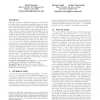Free Online Productivity Tools
i2Speak
i2Symbol
i2OCR
iTex2Img
iWeb2Print
iWeb2Shot
i2Type
iPdf2Split
iPdf2Merge
i2Bopomofo
i2Arabic
i2Style
i2Image
i2PDF
iLatex2Rtf
Sci2ools
PODC
2006
ACM
2006
ACM
Local approximation schemes for topology control
This paper presents a distributed algorithm for wireless adhoc networks that runs in polylogarithmic number of rounds in the size of the network and constructs a lightweight, linear size, (1+ε)-spanner for any given ε > 0. A wireless network is modeled by a d-dimensional α-quasi unit ball graph (αUBG), which is a higher dimensional generalization of the standard unit disk graph (UDG) model. The d-dimensional α-UBG model goes beyond the unrealistic “flat world” assumption of UDGs and also takes into account transmission errors, fading signal strength, and physical obstructions. The main result in the paper is this: for any fixed ε > 0, 0 < α ≤ 1, and d ≥ 2 there is a distributed algorithm running in O(log n·log∗ n) communication rounds on an n-node, d-dimensional α-UBG G that computes a (1+ε)-spanner G of G with maximum degree Δ(G ) = O(1) and total weight w(G ) = O(w(MST(G)). This result is motivated by the topology control problem in wireless ad-hoc ne...
Distributed Algorithm | Distributed And Parallel Computing | PODC 2006 | Topology Control | Wireless Adhoc Networks |
| Added | 14 Jun 2010 |
| Updated | 14 Jun 2010 |
| Type | Conference |
| Year | 2006 |
| Where | PODC |
| Authors | Mirela Damian, Saurav Pandit, Sriram V. Pemmaraju |
Comments (0)

